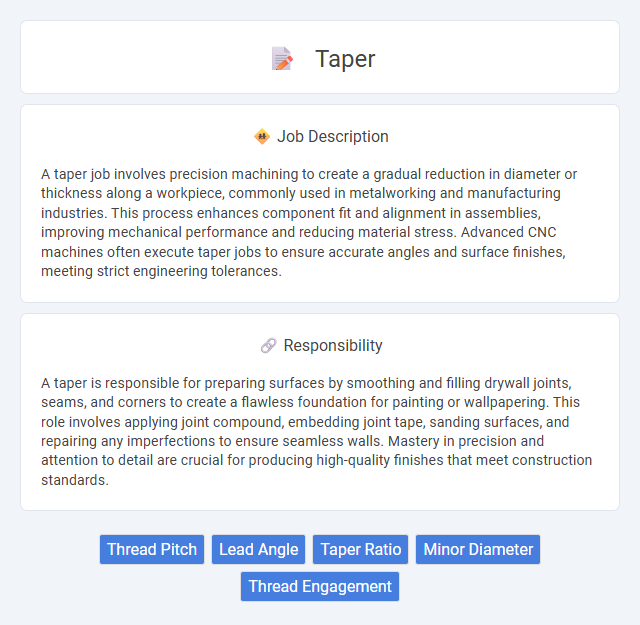
A taper job involves precision machining to create a gradual reduction in diameter or thickness along a workpiece, commonly used in metalworking and manufacturing industries. This process enhances component fit and alignment in assemblies, improving mechanical performance and reducing material stress. Advanced CNC machines often execute taper jobs to ensure accurate angles and surface finishes, meeting strict engineering tolerances.
Individuals with strong attention to detail and steady hand coordination are likely suitable for a taper job, given the precision required in shaping and smoothing surfaces. People who might struggle with repetitive tasks or have difficulty maintaining focus for extended periods may find this work challenging. Those comfortable working in physically demanding environments and adapting to sometimes noisy settings could have a higher probability of success in tapering roles.
Qualification
Taper jobs require proficiency in operating precision machinery to shape and finish metal or wood components with exact dimensions. Candidates typically need a background in mechanical or metalworking trades, strong attention to detail, and the ability to read blueprints and technical drawings accurately. Certification in CNC machining or welding can enhance qualifications and improve job prospects in the tapering industry.
Responsibility
A taper is responsible for preparing surfaces by smoothing and filling drywall joints, seams, and corners to create a flawless foundation for painting or wallpapering. This role involves applying joint compound, embedding joint tape, sanding surfaces, and repairing any imperfections to ensure seamless walls. Mastery in precision and attention to detail are crucial for producing high-quality finishes that meet construction standards.
Benefit
Taper jobs probably enhance the overall fit and finish of products by creating smooth, angled edges that improve aesthetics and functionality. These tasks are likely to increase production efficiency by reducing material waste and simplifying assembly processes. Improved safety and ergonomics may also result from tapered components, decreasing the risk of injury during handling and use.
Challenge
Taper jobs often present challenges due to the precision required in shaping materials to exact specifications, with a high probability of errors affecting the final product's quality. Workers may face difficulties maintaining consistent taper angles over prolonged periods, increasing the chances of rework and material waste. Equipment calibration and operator skill variability can also play significant roles in the likelihood of encountering production setbacks in taper operations.
Career Advancement
A taper job offers critical hands-on experience in metal finishing and surface preparation, serving as a foundation for career advancement in manufacturing, automotive, and aerospace industries. Mastery of precise measurement tools and surface treatment techniques enhances employability and opens pathways to roles such as quality control inspector, production supervisor, or materials technician. Continuous skill development and certifications in welding and machining further boost prospects for leadership positions and specialized technical careers.
Key Terms
Thread Pitch
Taper jobs involve machining tapered surfaces with precise thread pitch to ensure accurate screw thread engagement and mechanical fit. Thread pitch, defined as the distance between adjacent thread crests, is critical in taper jobs to maintain thread integrity and avoid loosening under load. Accurate control of thread pitch in taper jobs enhances performance in applications like pipe fittings, fasteners, and mechanical assemblies requiring secure, leak-proof connections.
Lead Angle
The lead angle in taper jobs directly influences the axial and radial forces experienced during machining, affecting surface finish and tool life. Selecting an optimal lead angle minimizes chatter and enhances dimensional accuracy on tapered surfaces. Common lead angles range from 15deg to 45deg, depending on the material and taper specifications.
Taper Ratio
Taper jobs require precise control of the taper ratio, which is the gradual reduction in diameter or thickness along a component. Optimizing the taper ratio enhances mechanical strength, fit accuracy, and performance in applications such as shafts, drills, and molds. Advanced CNC machining and measurement tools enable the creation of consistent taper ratios, ensuring high-quality finishes and dimensional accuracy.
Minor Diameter
The taper job involves precision machining to create conical surfaces where the minor diameter is a critical measurement ensuring proper fit and function. Accurate control of the minor diameter in a taper job prevents issues like misalignment or inadequate sealing, which are essential in applications such as threaded fasteners and tapered shafts. Maintaining tight tolerances on the minor diameter enhances the overall performance and durability of the tapered component.
Thread Engagement
Taper jobs with precise thread engagement ensure optimal fastening strength by maximizing the contact area between mating surfaces. Proper thread engagement reduces the risk of loosening under vibration and distributes load evenly along threads, enhancing joint reliability. Thread engagement length is typically designed to match material thickness and thread pitch for superior mechanical performance in tapered connections.
 kuljobs.com
kuljobs.com